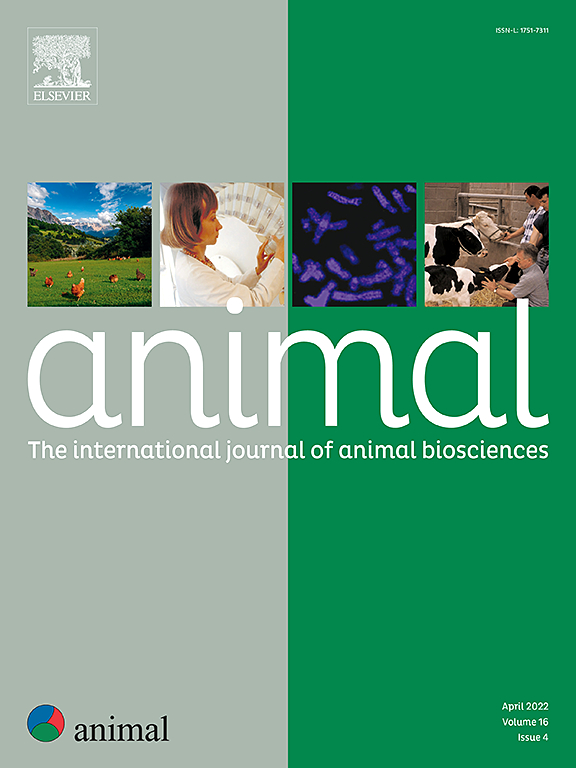生长兔日粮中添加小球藻和植物油:对生长、消化率、血浆代谢物以及盲肠发酵和微生物群的影响
IF 4
2区 农林科学
Q1 AGRICULTURE, DAIRY & ANIMAL SCIENCE
引用次数: 0
摘要
在家畜日粮中添加微藻已被证明可提高动物的生产率、免疫反应和肉质。然而,小球藻(Chlorella vulgaris)在生长兔营养中的作用却鲜有研究,现有的研究主要集中在低添加量(1%)及其对兔生长和免疫反应的影响。本研究评估了饲喂不同小球藻和粗脂肪添加量日粮的生长兔的生长性能、营养物质消化率、血浆代谢物、盲肠发酵活性和盲肠微生物群组成。共饲喂了 648 只格里莫杂交兔(33 日龄;841 ± 140 克活体重),采用双因子设计,饲喂六种试验日粮(生长试验中每种日粮饲喂 96 只兔子),日粮中含有三种水平的小球藻(0、1 和 2%)和两种水平的粗脂肪(3% 和 5%),粗脂肪是通过添加大豆油(分别为 1% 和 3%)获得的。试验持续了 38 天,直至屠宰。从 47 天龄到 51 天龄,72 只兔子(每种日粮 12 只)接受了消化率试验。51 日龄时,收集了 36 只兔子(每种饲料 6 只)的血浆和盲肠样本,以分析血浆代谢物、盲肠发酵物和盲肠微生物群。加入小球藻后,家兔 71 日龄时的活重(平均 2 700 克)、增重(48.8 克/天)和饲料转化率(3.27)均未受影响,而粗脂肪从 3% 增加到 5% 时,饲料转化率有所提高(-5%;P <;0.001)。粗脂肪添加量为 2% 时,ADF(23.2 vs 20.9%; P <0.05)和粗脂肪(83.8 vs 85.6%; P <0.01)的消化率有所提高;粗脂肪添加量为 5% 时,粗脂肪(82.4 vs 86.9%; P <0.001)和总能(57.3 vs 58.7%; P <0.001)的消化率也有所提高。在粗脂肪含量为 5%的日粮中,血浆非酯化脂肪酸减少(-19%;P <;0.05)。小球藻和粗脂肪添加量都不会影响其他血浆代谢物、盲肠发酵或盲肠微生物群。总之,在生长兔日粮中添加最高达 2% 的小球藻不会对日粮营养价值、动物表现或盲肠活动产生显著影响。另一方面,将粗脂肪提高到 5%可提高总体饲料效率。本文章由计算机程序翻译,如有差异,请以英文原文为准。
Chlorella and vegetable oil inclusion in diets for growing rabbits: effects on growth, digestibility, plasma metabolites, and caecal fermentations and microbiota
The inclusion of microalgae in livestock diets has been shown to enhance animal productivity, immune response, and meat quality. However, the role of chlorella (Chlorella vulgaris) in growing rabbit nutrition has been scarcely explored, with available studies focusing on low inclusion levels (<1%) and their effects on rabbit growth and immune response. This study evaluated the growth performance, nutrient digestibility, plasma metabolites, caecal fermentative activity, and caecal microbiota composition of growing rabbits fed diets with different inclusion levels of chlorella and crude fat. A total of 648 mixed-sex Grimaud crossbred rabbits (33 d of age; 841 ± 140 g live weight) were fed six experimental diets (96 rabbits per diet for the growth trial) based on a bifactorial design with three dietary inclusion levels of chlorella (0, 1, and 2%) and two levels of crude fat (3 and 5%) obtained by the inclusion of soybean oil (1 and 3%, respectively). The trial lasted 38 days until slaughter. From 47 to 51 days of age, 72 rabbits (12 per diet) were submitted to a digestibility trial. At 51 days of age, samples of plasma and caecal content were collected from 36 rabbits (six rabbits per diet) to analyse plasma metabolites, caecal fermentations, and caecal microbiota. Rabbit live weight at 71 days of age (2 700 g, on average), weight gain (48.8 g/d) and feed conversion ratio (3.27) were unaffected by chlorella inclusion, while feed conversion ratio improved (−5%; P < 0.001) with an increase of crude fat from 3 to 5%. The digestibility of ADF (23.2 vs 20.9%; P < 0.05) and crude fat (83.8 vs 85.6%; P < 0.01) improved with the inclusion of chlorella at 2%, as well as the digestibility of crude fat (82.4 vs 86.9%; P < 0.001) and gross energy (57.3 vs 58.7%; P < 0.001) with crude fat inclusion at 5%. Plasma non-esterified fatty acids decreased (−19%; P < 0.05) in diets with 5% crude fat. Neither chlorella nor crude fat inclusion levels affected other plasma metabolites, caecal fermentations, or caecal microbiota. Overall, the inclusion of chlorella up to 2% in diets for growing rabbits did not significantly affect diet nutritional value, animal performance, or caecal activity. On the other hand, increasing crude fat to 5% improved the overall feed efficiency.
求助全文
通过发布文献求助,成功后即可免费获取论文全文。
去求助
来源期刊

Animal
农林科学-奶制品与动物科学
CiteScore
7.50
自引率
2.80%
发文量
246
审稿时长
3 months
期刊介绍:
Editorial board
animal attracts the best research in animal biology and animal systems from across the spectrum of the agricultural, biomedical, and environmental sciences. It is the central element in an exciting collaboration between the British Society of Animal Science (BSAS), Institut National de la Recherche Agronomique (INRA) and the European Federation of Animal Science (EAAP) and represents a merging of three scientific journals: Animal Science; Animal Research; Reproduction, Nutrition, Development. animal publishes original cutting-edge research, ''hot'' topics and horizon-scanning reviews on animal-related aspects of the life sciences at the molecular, cellular, organ, whole animal and production system levels. The main subject areas include: breeding and genetics; nutrition; physiology and functional biology of systems; behaviour, health and welfare; farming systems, environmental impact and climate change; product quality, human health and well-being. Animal models and papers dealing with the integration of research between these topics and their impact on the environment and people are particularly welcome.
 求助内容:
求助内容: 应助结果提醒方式:
应助结果提醒方式:


